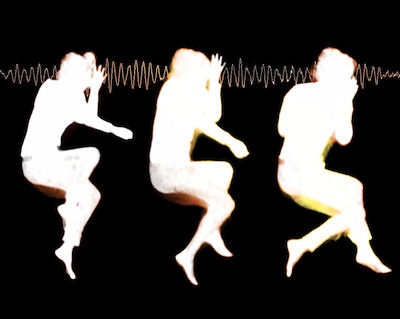REVOLVE from dusk to dawn
04/10/2011 - 05/10/2011
Production Details
Created by an internationally renowned collaborative team – media artist Anne Niemetz (NZ /Germany/USA), choreographer/performer Carol Brown (UK/NZ), sound artist Russell Scoones (UK/NZ), lighting designer Margie Medlin (Aus/UK) and sleep scientist Philippa Gander (NZ) – the work sheds light on the ‘stuff’ dreams are made of, the night-stories and bodily states that shape our sleeping hours.
This intimate work unfolds through story-telling, sound, light, video and dance, following the path of the sleeper’s mind and body through the night. Aided by her sensor-equipped costume, solo dancer Carol Brown guides the audience through this immersive experience, heightening, changing or shifting the nature of the performance through interaction with the evolving sound and light environment. Driven by a curiosity about the body, its rhythms and potential for change, REVOLVE brings audiences an intimate, multi-sensory encounter that expands definitions of contemporary performance.
Solo dancer Carol Brown
A strangely beautiful aesthetic generated from sleep science
Review by Kate Sullivan 05th Oct 2011
The performance space is set in the middle of the dome with two rows of seating facing into each other on either side of the stage. A projected image of a human figure shines onto the floor through a thick layer of perspex that hangs from the ceiling. Occasionally –if you are quick enough to look at all the right moments- you see the image writhing into various sleeping positions. Moving from supine to fetal. The space is literally buzzing with electrical sounds that further enhance my mad scientist image.
As explained in the program, Revolve is a multimedia performance inspired by sleep science. Five collaborators, Carol Brown, Philippa Gander, Margie Medlin, Anne Niemetz and Russell Scoones, whose specialties range from performer to chronobiologist, have merged voice, sound, light, video and dance to trace the path of a sleeper’s mind and body from dusk to dawn.
Scientific words jump out of the program, challenging me to make sense of what I read about the nature of this work. I wonder what sort of aesthetic will be generated from brainwaves, sonic feedback and wearable electronic sensor technology.
Without warning, Carol Brown steps behind a screen that is hanging directly opposite me behind the opposing seats. Her dreamy voice speaks slowly into the microphone, enlightening the audience about sleep. Emerging from behind the screen, the dancer strides onto the performance space, making direct eye contact with the audience. This terrifies me as I’m one of those shy audience members that fears having attention drawn to me by the performers. But thankfully she walks straight past me.
She slumps into a lone chair at the back of the stage and pulls a microphone from her handbag like she is retrieving her purse to pay for a drink at a bar. She removes the long trench coat she has been wearing and reveals the wearable electronic sensor technology that I have been eagerly waiting to see. Overtop of her performance blacks, the dancer wears red wires that snake around her body, reminding me of red liquorish. Although the costume has been largely designed to suit the technological demands of this performance, I find the mesh of red wires strangely beautiful.
The dancer makes her way across the stage and pushes the slab of perspex, which swings back and forth like a pendulum. As the perspex swings, the performer rolls underneath this. Her arms sweep the floor creating a beautiful pathway. She continues by performing subtle, curling movements reminiscent of an irritable sleeper. These movements trigger soft buzzes of sound.
The dancer begins to spin. She spins, arms out to the side 10,12,20,50 and now I’ve lost count of how many times. I want to look away to save myself from feeling giddy, I can’t understand why the dancer isn’t stumbling across the stage, especially since she has had her eyes closed during the entirety of her spins.
Like the sound, some of the choreography is composed, yet the rest of it is improvised according to the performer’s interactions with her environment. The phase of REM sleep (characterized by nervous muscle twitches and rapid eye movement) is clearly distinguishable as the intensity of the dancer’s movements increase. During this phase of the performance her movements become more frenzied and I lean forward in my seat with excitement. As the dancers intensity increases, as does the sound. Not everyone is finding the electrifying noises as interesting as I –a young child in the audience complains “it’s hurting my ears”.
In the phase that I assume represents having woken up, the dancer re-dresses herself in her trench coat then walks purposefully, staring at the audience the entire time. She sits on a seat between two audience members and stares directly at me. As the dancer crosses the audience/performer threshold, a mundane moment is created, and this creates one of my favorite moments in the performance. The audience sitting across from me look as if they are part of the performance, as if they are all passengers on a subway. I am briefly terrified again, as the dancer strolls past me, staring. But lucky for me she slips behind the screen again to finish the show.
Through all of the the science is an entrancing beauty that is aurally and visually engaging. My mind is swimming with layers of sound and images that have intrigued and delighted. I am pleased by the opportunity to ask questions at the commencement of the show. This sheds some light on how such a unique idea was conceived.
_______________________________
For more production details, click on the title above. Go to Home page to see other Reviews, recent Comments and Forum postings (under Chat Back), and News.
Copyright © in the review belongs to the reviewer





Comments